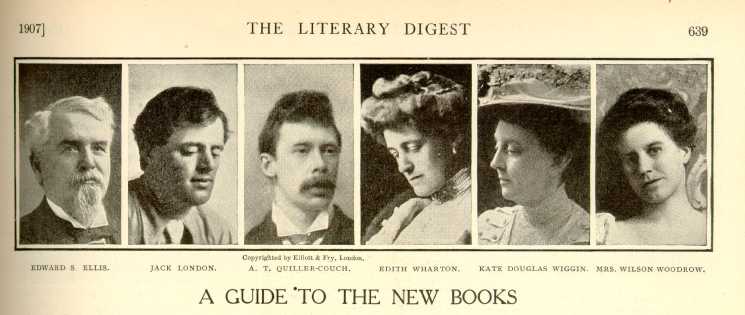| Guide to the New Books [excerpt] | ||
Wharton, Edith. Madame de Treymes. Illustrations in color. 12mo, pp. 147. New York: Charles Scribner's Sons. $1.
 [Description: Photographic portrait of Mrs. Wharton in three-quarter profile. Photographer unknown.]
[Description: Photographic portrait of Mrs. Wharton in three-quarter profile. Photographer unknown.]
While the expectations raised by Mrs.Wharton's brilliant novel of society are hardly fulfilled by her new book, which is slight in volume and exceedingly simple in theme, there are certain compensating qualities in #x00AB;Madame de Treymes» that amply atone for the possible disappointment of those who had prepared themselves for a #x00AB;House of Mirth»a la francaise. The aristocratic life of the Faubourgs is full of peril for the American novelist. The life and ideals of the old noblesse of France are about as alien from our own as it is possible to conceive of. These descendants of men who, for a cause, went to the guillotine with a smile on their lips, have little in common with the children of modern progress.
It is, then, no slight achievement for an American writer to have depicted successfully, and even brilliantly, so exotic a phase of modern French life. This feat, necessarily a tour de force, Mrs. Wharton has accomplished. Her pages exhale the undefinable atmosphere and aroma of aristocratic French life of the present day—a phase of life almost incomprehensible to the foreigner.
It is in the portrayal of Madame de Treymes (sister-in-law to the wronged wife) that the subtle artistry of Mrs. Wharton is chiefly revealed. Madame de Treymes is a curiously fascinating study of exotic human nature, recalling by certain traits those exquisite dry-point etchings of Paul Helleu which radiate a species of poignant charm. Such women were known to Leonardo da Vinci and Beaudelaire. They are the full flowering of an ancient soil, deep-rooted in the past and just touched by the breath of the decadence. This patrician lady, moving among her lively American acquaintances and dominating them all by sheer force of personality, reminds us of some Mona Lisa stranded in a Fifth-Avenue ballroom. There is nothing finer in Mrs. Wharton's gallery. The author's style is full of distinction and is marked by those exquisite reserves that characterize the born artist. Slight as the volume is, it reveals artistic possibilities hitherto undiscerned.
| Guide to the New Books [excerpt] | ||